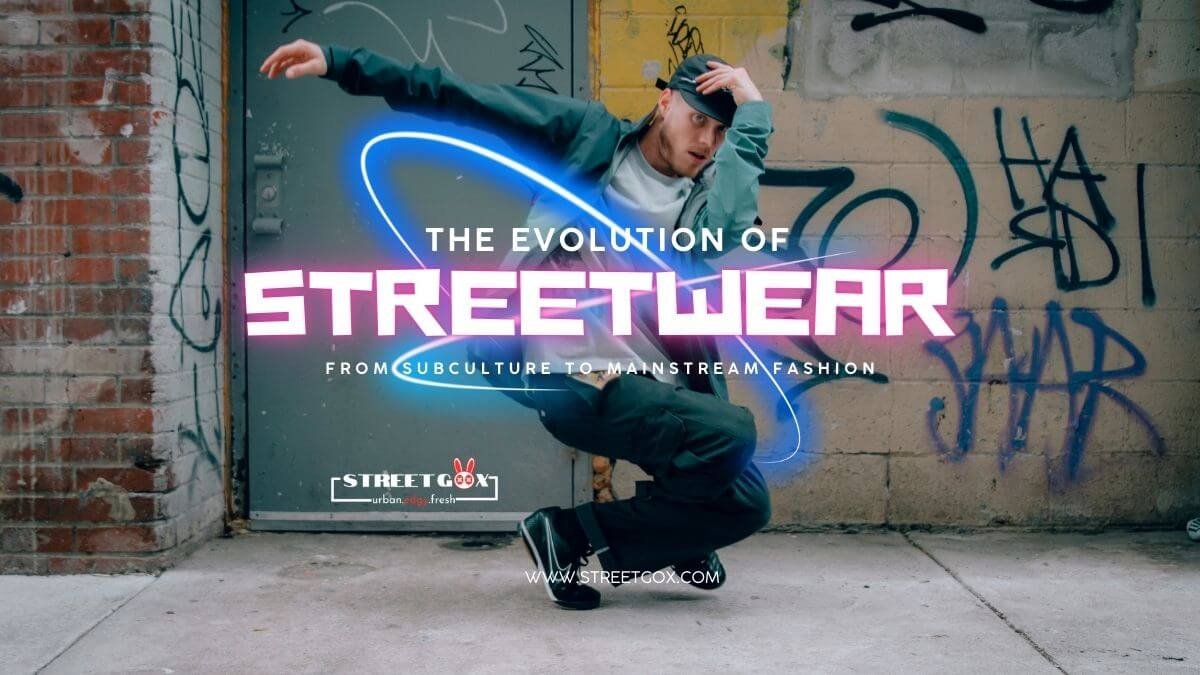
Streetwear has become a global fashion phenomenon that has its roots deeply entrenched in the subculture of skateboarding and hip-hop music. At its core, streetwear fashion represents a rebellious spirit and a desire to stand out from the mainstream fashion world. In recent years, streetwear has evolved from being a niche subculture to a mainstream fashion trend that has taken the world by storm.
The history of streetwear can be traced back to the 1980s, where it emerged as a form of self-expression among disenfranchised youth who sought an alternative to the mainstream fashion culture. Over the years, it has evolved into a multibillion-dollar industry with a global reach, encompassing everything from high-end fashion brands to affordable streetwear clothing lines.
In this article, we will delve into the evolution of streetwear and explore its origin and cultural significance. We will examine the rise of streetwear from its subculture roots and the key figures who shaped it. So, buckle up and get ready to take a deep dive into the fascinating world of streetwear fashion. And if you already know about the history of streetwear but want to take your streetwear fashion game to the next level, check out our detailed streetwear style guide.
Table of Contents
The Roots of Streetwear
Streetwear fashion originated in the 1970s and 1980s, where it emerged as a subculture and as a form of rebellion against the established cultural norms among young people who were disillusioned with the mainstream fashion culture.
It all started when a group of young people in California started wearing casual clothing inspired by skate culture. These clothes were comfortable, functional, and could withstand the physical demands of skateboarding. At the time, these clothes were not readily available in mainstream stores, so skaters began creating their own styles.
In the early 1980s, the rise of hip hop and rap music further popularized streetwear fashion. Artists like Run-DMC and LL Cool J were known for wearing oversized t-shirts, baggy pants, and Adidas sneakers, which became popular among fans. The style became known as “athletic streetwear,” and it quickly caught on in urban communities across the United States.
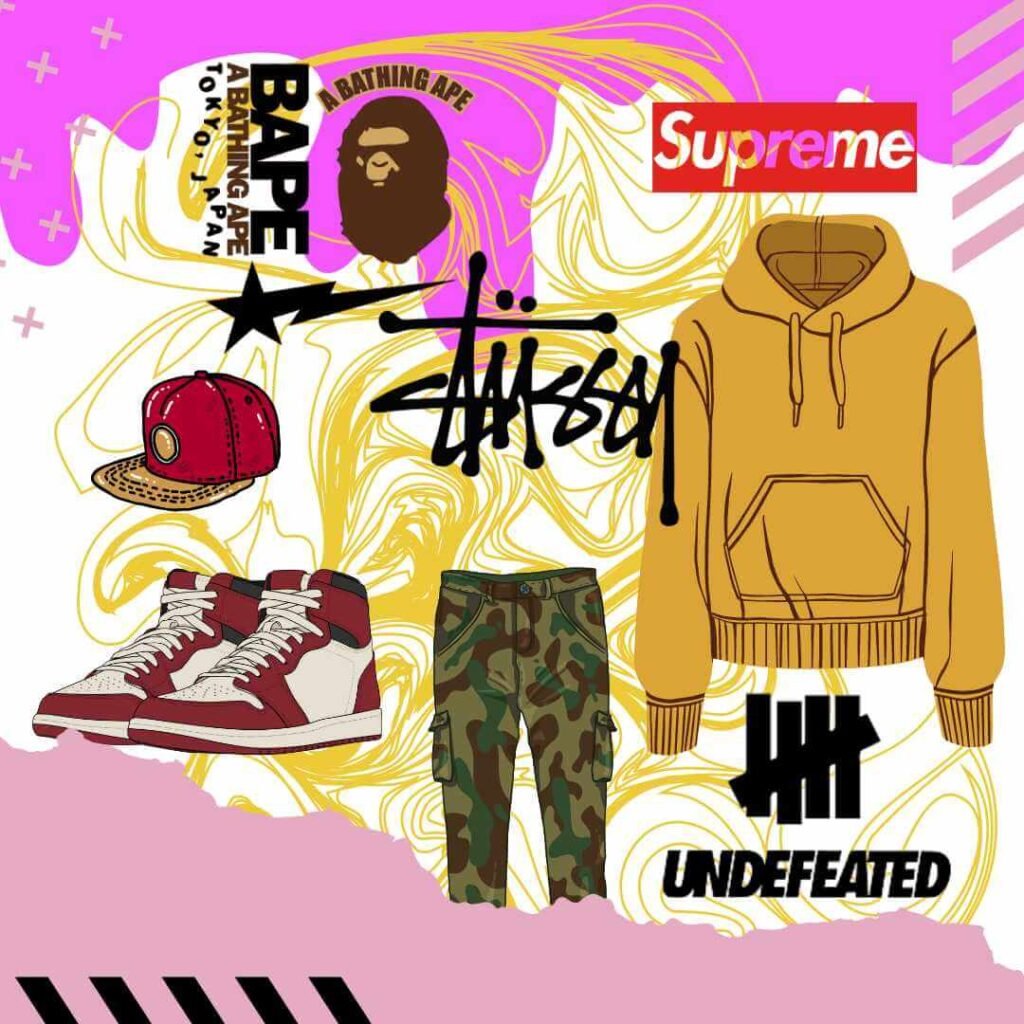
As the popularity of streetwear grew, a few brands emerged as key players in the industry. One of the first brands was Stüssy, which was founded in the 1980s by Shawn Stüssy. The brand started as a surfboard company, but soon evolved to include graphic t-shirts and other streetwear staples. Another influential brand was Supreme, which was founded in New York City in the early 1990s. Supreme quickly gained a following among skaters and hip-hop fans, and it is now one of the most recognizable streetwear brands in the world.
In addition to Stüssy and Supreme, other streetwear brands emerged during this time, including A Bathing Ape (BAPE) and Undefeated. These brands were known for their graphic t-shirts, bold logos, and unique collaborations with artists and other brands.
The rise of streetwear in the 1990s marked a significant shift in the fashion industry. For the first time, a subculture was influencing mainstream fashion, and streetwear became a symbol of rebellion and individuality. As a result, high-end fashion brands began incorporating streetwear elements into their collections, blurring the lines between high fashion and streetwear.
Overall, the roots of streetwear can be traced back to the skate culture of the 1970s and 1980s, but its popularity exploded in the 1990s thanks to the influence of hip hop and the emergence of influential brands like Stüssy and Supreme. The unique style and individuality of streetwear fashion continue to influence fashion and pop culture today.
The Culture and Community of Streetwear
Streetwear has always been more than just fashion. It’s a culture, a community, and a way of life for many people around the world. Streetwear is about more than just wearing the latest trends, it’s a way to express individuality, creativity, and personality. The culture and community of streetwear are what make it so special and what will continue to drive its evolution for years to come.
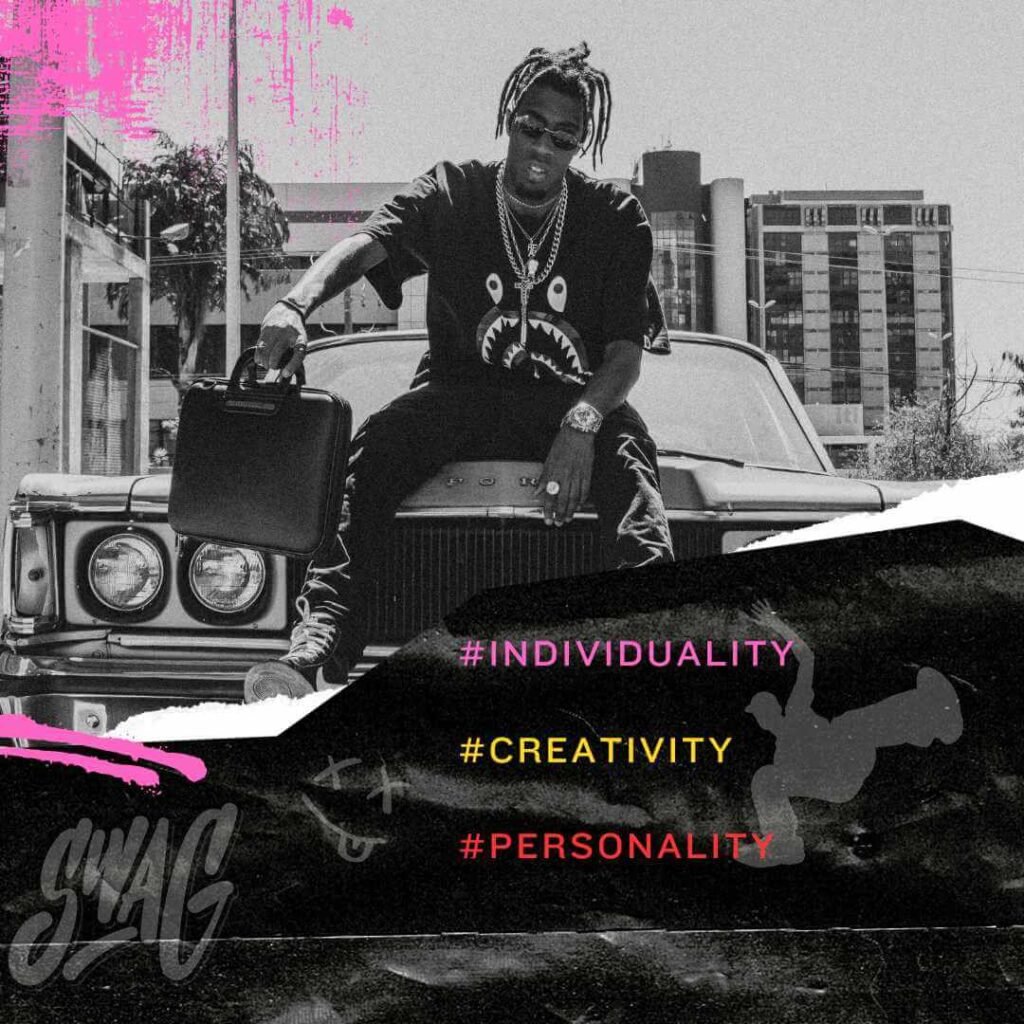
The culture of streetwear is rooted in the idea of subversion and rebellion. Streetwear emerged as a way for young people to express their individuality and to stand out from mainstream fashion. It was a rejection of the traditional fashion industry and its exclusivity. Streetwear was about creating something new, fresh, and exciting, something that spoke directly to young people and their experiences.
As streetwear evolved over time, it became more than just a style of clothing. It became a way of life, a culture that included art, music, and other forms of self-expression. Streetwear created a sense of community and belonging among its followers, a shared identity and a common vision. This community grew to include people from all walks of life, from all over the world.
The community of streetwear is inclusive and diverse. It’s a community that celebrates individuality and encourages creativity. Streetwear has always been about breaking down barriers, about creating a space where anyone can be themselves and feel comfortable. This community is welcoming to all, regardless of race, gender, or socioeconomic status.
In recent years, streetwear has become more mainstream, but its culture and community remain strong. Streetwear has been embraced by high fashion brands and has become a part of the fashion industry in a way that was once unthinkable. Despite this mainstream success, the culture and community of streetwear continue to thrive, and the values of individuality, creativity, and inclusivity remain at its core.
The Globalization of Streetwear Fashion
The influence of streetwear has transcended borders, and it has become a global phenomenon. In particular, Japan has played a significant role in the evolution of streetwear fashion. In the 1980s, Japanese youth were drawn to American hip hop culture, and this interest resulted in the emergence of their own streetwear fashion.
Japanese streetwear is often characterized by its attention to detail and use of high-quality materials. Some of the most iconic Japanese streetwear brands include A Bathing Ape (BAPE), Comme des Garçons, and Undercover. These brands have been influential in shaping streetwear fashion and have gained a significant following among streetwear enthusiasts.
Other countries have also contributed to the rise of street culture. In the UK, brands like Palace Skateboards and A-COLD-WALL* have gained popularity in recent years. Meanwhile, in Korea, the brand Ader Error has become one of the most influential streetwear brands in the region.
The global influence of streetwear has resulted in a diverse and vibrant community of streetwear enthusiasts worldwide. It has become a means of expression for individuals to showcase their individuality and identity through their clothing.
The Impact of Sports and Athletic Wear
In the late 20th century, athletic wear and streetwear began to intersect, with the rise of brands like Nike and Adidas having a significant impact on streetwear fashion. These brands were initially focused on producing clothing and footwear for athletes, but they soon became popular with non-athletes as well, who were drawn to the comfort and stylish designs of their products.
One of the earliest examples of this trend was the Nike Air Jordan, a line of sneakers that was launched in 1985 in collaboration with the famous basketball player Michael Jordan. The Air Jordan line quickly became popular not just among basketball players but also among fans of hip hop music and streetwear fashion. This was due in part to the fact that Michael Jordan was one of the most famous athletes of his time and a cultural icon in his own right, and also because the sneakers were stylish and unique.
Adidas also played a significant role in the rise of sports-inspired streetwear, with their iconic three-stripe design becoming synonymous with the brand. The Adidas tracksuit, in particular, became a popular fashion statement in the 1980s and 1990s, worn by everyone from athletes to musicians and fans of streetwear fashion.
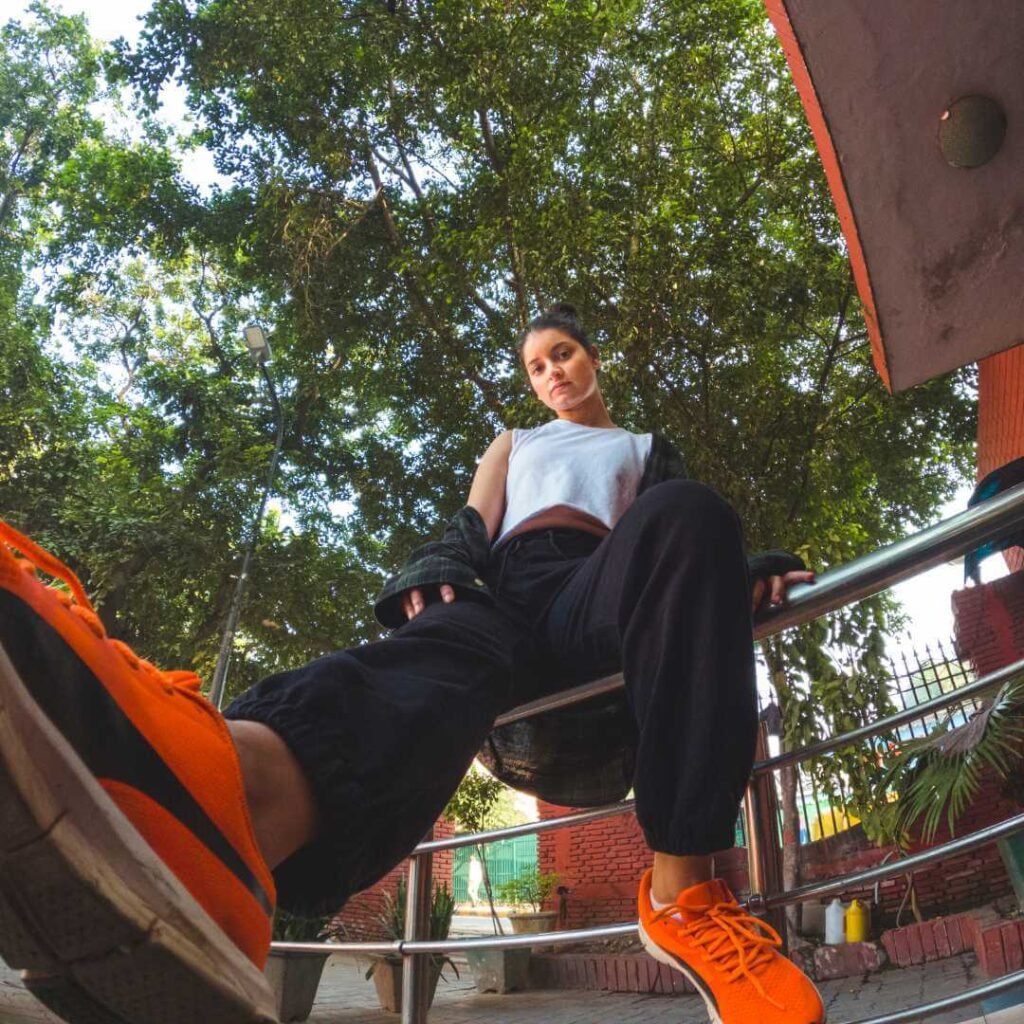
The intersection of sports culture and streetwear fashion has continued to evolve over the years, with both industries influencing each other in new and interesting ways. For example, the popularity of skateboarding and snowboarding has led to the rise of brands like Vans and Burton, which produce shoes and apparel that are designed for use in these sports but are also popular among fans of streetwear fashion.
In recent years, the influence of sports and athletic wear on streetwear fashion has only grown stronger, with brands like Nike and Adidas collaborating with streetwear labels like Off-White and A Bathing Ape. These collaborations have resulted in some of the most sought-after pieces in streetwear fashion, with limited edition sneakers and apparel selling out almost instantly upon release.
Overall, the impact of sports and athletic wear on streetwear fashion cannot be overstated. The comfort, functionality, and style of these products have made them a staple in the wardrobes of people all over the world, from athletes to fashion enthusiasts. As streetwear continues to evolve and grow, it will be interesting to see how the influence of sports and athletic wear continues to shape the industry.
The Intersection of Streetwear and High Fashion
Over the past few decades, streetwear has evolved from an underground subculture to a multi-billion-dollar industry that has intersected with high fashion. In recent years, we’ve seen an increasing number of collaborations between streetwear brands and luxury fashion houses, as well as high-end streetwear brands emerging on their own.
One of the reasons for this intersection is the changing landscape of fashion itself. Luxury fashion brands are now embracing streetwear’s casual, urban aesthetic and incorporating it into their high-end collections. On the other hand, streetwear brands are incorporating high-quality materials and luxury details into their designs, bringing a new level of sophistication to streetwear.
The collaboration between streetwear and high fashion has also been driven by consumer demand. As streetwear has become more mainstream and popular, consumers are looking for ways to incorporate it into their everyday wardrobes. The intersection of streetwear and high fashion allows consumers to do this in a way that is both fashionable and elevated.
We’ve seen several high-profile collaborations between streetwear and luxury fashion brands over the years. One of the most notable was the collaboration between Louis Vuitton and streetwear brand Supreme in 2017, which caused a frenzy among fashion enthusiasts. Another notable collaboration was the partnership between Nike and Off-White, which saw designer Virgil Abloh create a collection of sneakers and clothing that quickly became some of the most sought-after items in the fashion world.
As we look to the future, it’s clear that the intersection of streetwear and high fashion will continue to grow and evolve. We can expect to see more collaborations between streetwear brands and luxury fashion houses, as well as the emergence of new high-end streetwear brands. With the ever-changing landscape of fashion, it’s exciting to see where this intersection will take us next.
Streetwear and Identity Politics
Streetwear has long been a form of self-expression for many individuals, particularly those who belong to subcultures and marginalized communities. It has served as a way for people to showcase their identities, beliefs, and cultural roots. In recent years, streetwear has become increasingly tied to identity politics and social and political issues.
One of the most significant ways streetwear has intersected with identity politics is through the Black Lives Matter movement. Following the murders of George Floyd, Breonna Taylor, and other Black individuals at the hands of police officers, many streetwear brands and designers have used their platforms to raise awareness and funds for racial justice organizations. Brands like Pyer Moss and Fear of God have released collections that center on Black liberation and protest. These collections often feature slogans like “Justice for George Floyd” and “Black Lives Matter” printed on T-shirts, hoodies, and other streetwear staples.

Beyond its role in protest movements, streetwear has always been used to express cultural identity. For example, in the 1980s and 1990s, the rise of hip hop music and culture led to the emergence of brands like FUBU and Rocawear, which created clothing that was specifically designed for and marketed to Black youth. Similarly, brands like BAPE and Kith have drawn inspiration from Japanese street culture and incorporated traditional motifs and symbols into their designs.
In recent years, streetwear has also been embraced by members of the LGBTQ+ community as a way to express their identities. Brands like ASOS and H&M have released collections that feature gender-neutral clothing, while designers like Rick Owens and JW Anderson have created clothing that challenges traditional notions of masculinity and femininity. These designs often incorporate bright colors, unusual silhouettes, and experimental materials.
At its core, streetwear is all about individuality and self-expression. For many people, the clothing they wear is a direct reflection of who they are and what they believe in. Streetwear has provided a platform for marginalized communities to express their identities and cultures, and has played an important role in social and political movements. As streetwear continues to evolve and expand, it will undoubtedly remain a vital part of the cultural landscape.
Celebrity Culture and Streetwear
The influence of celebrities on streetwear fashion has been undeniable. Icons like Kanye West and Pharrell Williams have been at the forefront of streetwear culture, with their personal style and fashion choices shaping trends and inspiring new collections.
Kanye West is perhaps one of the most influential figures in modern streetwear. His collaborations with Nike, Louis Vuitton, and Adidas have led to some of the most sought-after sneakers and clothing pieces in recent years. His Yeezy brand, which is now in partnership with Adidas, has become a staple in streetwear fashion, with its minimalist designs and earthy color palettes.
Another celebrity who has made waves in the streetwear scene is Pharrell Williams. His Billionaire Boys Club and Ice Cream brands, which he co-founded with Nigo, have become synonymous with streetwear fashion. The brands feature bold graphics and colorful designs, which have inspired numerous other brands and designers.
In addition to West and Williams, there are numerous other celebrities who have contributed to the rise of streetwear culture. Rihanna‘s collaboration with PUMA resulted in the Fenty x PUMA line, which combines streetwear and high fashion elements. ASAP Rocky‘s partnerships with brands like Under Armour and Calvin Klein have also had a significant impact on streetwear fashion.
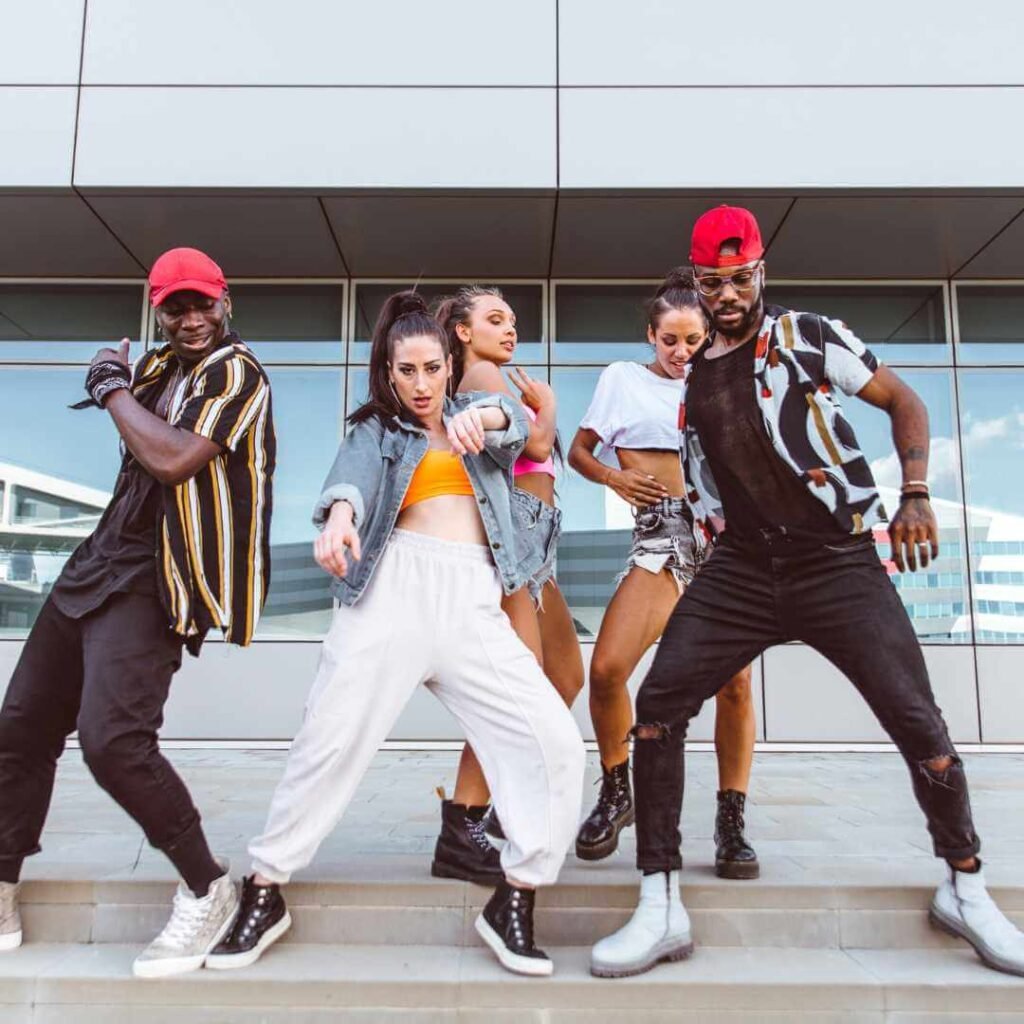
Celebrity-backed streetwear brands have also become increasingly popular. Sean Combs, also known as P. Diddy, launched his own brand, Sean John, in 1998, which quickly became a staple in the hip hop community. Jay-Z’s Rocawear brand, which he co-founded in 1999, has also had a significant impact on streetwear culture, with its bold designs and use of cultural references.
Celebrity collaborations with streetwear brands have also become commonplace. The Off-White x Nike collaboration, which was led by designer Virgil Abloh, resulted in some of the most popular sneakers of the past few years. Supreme’s collaborations with Louis Vuitton and The North Face have also been highly sought after by streetwear enthusiasts.
In essence, the influence of celebrity culture on streetwear fashion has been significant. Celebrities like Kanye West and Pharrell Williams have helped to push streetwear into the mainstream, and their unique style has inspired a new generation of streetwear enthusiasts. Celebrity-backed streetwear brands and collaborations between celebrities and streetwear labels have become more common, and they have helped to create a sense of exclusivity and hype around streetwear fashion.
The Impact of COVID-19 on Streetwear
The COVID-19 pandemic has drastically impacted the fashion industry, and streetwear fashion is no exception. The pandemic has had a significant impact on streetwear trends, leading to changes in the way people dress and consume fashion. In this section, we will explore the impact of COVID-19 on streetwear and how it has affected the industry.
One of the most significant impacts of the pandemic on streetwear has been the shift towards more comfortable and functional clothing. With people spending more time at home and less time going out, there has been a rise in loungewear and athleisure wear. Brands like Nike and Adidas, which specialize in sportswear, have seen a surge in demand for their products. Many streetwear brands have responded to this trend by releasing new lines of loungewear and comfortable clothing.
The pandemic has also led to the cancellation of many in-person events, such as fashion shows and product launches. As a result, many streetwear brands have turned to virtual events to showcase their products. Virtual events allow brands to connect with their audiences online and showcase their latest collections through live streams and online marketplaces. Brands like ComplexCon, which is one of the biggest streetwear events in the world, have shifted to a digital format due to the pandemic.
Another impact of the pandemic has been the emergence of new streetwear subcultures. With people spending more time at home, there has been a rise in online communities and social media subcultures. This has led to the emergence of new streetwear trends, such as cottagecore and techwear. Cottagecore is a subculture that embraces a rustic, countryside aesthetic, while techwear focuses on functional and futuristic clothing.
In addition to these trends, the pandemic has also led to a rise in sustainable and ethical streetwear fashion. With people becoming more aware of the impact of their actions on the environment, there has been a demand for more sustainable and ethical fashion. Many streetwear brands have responded to this trend by adopting more sustainable practices and materials. Brands like Patagonia and The North Face, which specialize in outdoor wear, have been at the forefront of the sustainable fashion movement.
Overall, the COVID-19 pandemic has had a significant impact on streetwear fashion. The shift towards more comfortable and functional clothing, the rise of virtual events, and the emergence of new streetwear subcultures are all trends that have emerged due to the pandemic. As the world continues to navigate the pandemic, it will be interesting to see how these trends evolve and shape the future of streetwear fashion.
The Future of Streetwear
Streetwear fashion has come a long way since its early days as a subculture and has now become a major player in the global fashion industry. As the demand for streetwear continues to grow, the future of streetwear seems to be headed towards sustainability and high fashion.
In recent years, there has been an increased focus on sustainability and ethical production practices in the fashion industry. Streetwear brands are no exception to this trend, with many emerging brands focusing on eco-friendly and sustainable practices.
Brands like Patagonia and Veja have paved the way for sustainable fashion by using recycled materials, minimizing waste, and reducing their carbon footprint. Many streetwear brands have followed suit, such as Pangaia, a brand that uses environmentally friendly materials like recycled plastic bottles and seaweed fibers in their clothing.
As of today, the influence of streetwear on global fashion trends can’t be denied. What started as a subculture in the streets of California has now become a global phenomenon that has impacted fashion trends worldwide.
Streetwear has also played a significant role in breaking down gender norms in fashion. Brands like Fear of God, Off-White, and A-Cold-Wall have been instrumental in blurring the lines between men’s and women’s fashion, creating a genderless approach to clothing.
As streetwear continues to evolve, its impact on global fashion trends is expected to grow. The demand for streetwear is only increasing, with new brands emerging every day and collaborations between streetwear and high fashion becoming more common.
Conclusion
From its humble beginnings as a subculture, streetwear has come a long way and has cemented its place in the global fashion industry. The evolution of streetwear has been shaped by a variety of factors, from skate culture to sports and athletic wear to celebrity culture and beyond.
As the fashion industry continues to grapple with issues of sustainability and ethical production practices, the emergence of eco-friendly and sustainable streetwear brands is a positive sign for the future of fashion.
The future of streetwear is also likely to see a continued crossover with high fashion, with collaborations and inspirations between the two becoming more common. And with streetwear’s influence on global fashion trends showing no signs of slowing down, it’s safe to say that streetwear is here to stay.
FAQs
1. What is the difference between streetwear and high fashion?
Streetwear is characterized by its comfortable and casual style, while high fashion is known for its high-end luxury and glamour. Streetwear often draws inspiration from popular culture and has a strong emphasis on functionality and comfort, whereas high fashion focuses on high-quality materials, intricate designs, and exclusivity.
2. How did hip hop culture influence streetwear fashion?
Hip hop culture heavily influenced streetwear fashion by popularizing oversized clothing, graphic t-shirts, and sneakers as fashion statements. Hip hop artists such as Run-DMC and LL Cool J made Adidas sneakers and tracksuits a fashion staple in the 1980s, and this trend continued to influence streetwear fashion throughout the decades.
3. What are some iconic streetwear brands?
Some iconic streetwear brands include Supreme, Stüssy, BAPE, Palace, Off-White, and Kith.
4. How has streetwear culture evolved over time?
Streetwear culture has evolved from a niche subculture to a mainstream fashion trend. It has become more inclusive and diverse, with a wide range of styles and designs that cater to different tastes and preferences.
5. Who started streetwear?
There is no clear founder of streetwear, as it emerged as a collective movement in the 1980s. However, brands like Stüssy and Supreme are often credited with popularizing the streetwear aesthetic.
6. What is the brief history of streetwear?
Streetwear emerged in the 1980s as a subculture that combined elements of skate, hip hop, and punk fashion. It was characterized by its comfortable and casual style, with an emphasis on functionality and individuality. Over time, streetwear has evolved into a mainstream fashion trend with global appeal.
7. What was the first street wear brand?
The first streetwear brand is often credited as being Stüssy, which was founded by Shawn Stussy in the 1980s.
8. How did streetwear become so popular?
Streetwear became popular through a combination of factors, including its association with popular culture, the rise of social media, and collaborations with high-end fashion brands. Streetwear fashion started gaining attention in the 1990s due to the influence of photographers and publications documenting the fashion of everyday people on the streets.
9. Who is the father of streetwear?
The term “father of streetwear” is often used to describe Hiroshi Fujiwara, who is a Japanese streetwear designer and DJ.
10. Why is it called streetwear?
Streetwear is called so because it originated from the streets and was worn by people who wanted to express their individuality through their clothing.
11. What is the aim of streetwear fashion?
The aim of streetwear is to provide a fashion style that is comfortable, functional, and expressive of an individual’s personality.
12. What is the principle of streetwear?
The principle of streetwear is to prioritize comfort and individuality over traditional fashion rules and trends.
13. Which country invented streetwear?
Streetwear originated in the United States, but it has become a global fashion trend with influences from different cultures and countries.
14. What makes streetwear unique?
Streetwear is unique because of its emphasis on individuality and its association with popular culture. It often incorporates bold graphics, casual and comfortable clothing, and collaborations with artists and designers.
15. How big is the streetwear market?
Latest data values the global streetwear market at USD 187,582.9 million in 2022, and it is expected to reach USD 230,877.25 million by 2028, with a compound annual growth rate (CAGR) of 3.52%.
